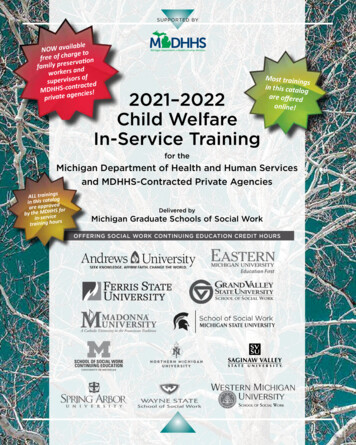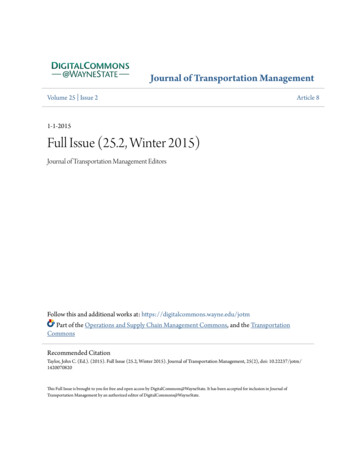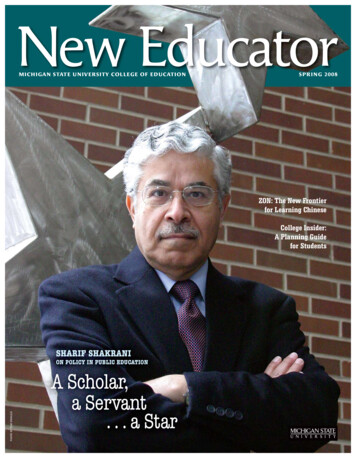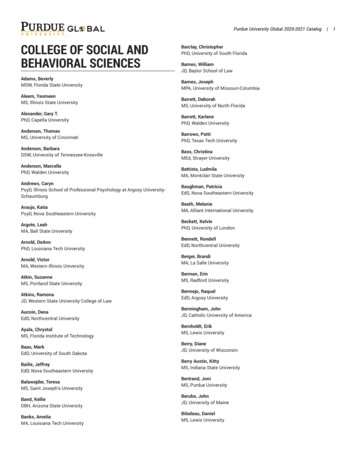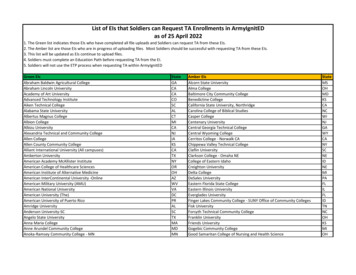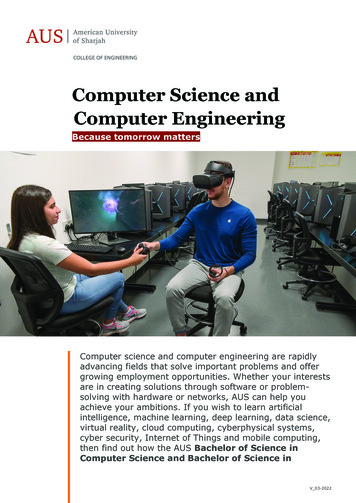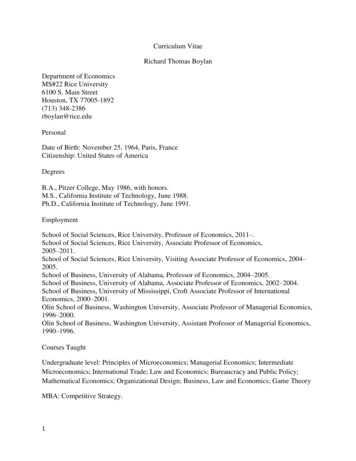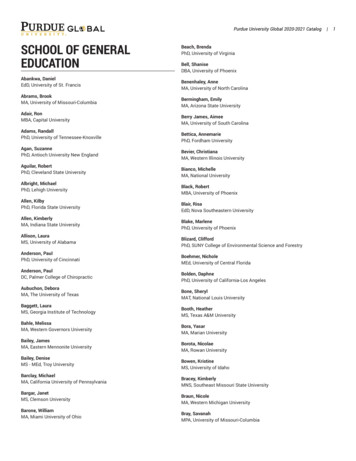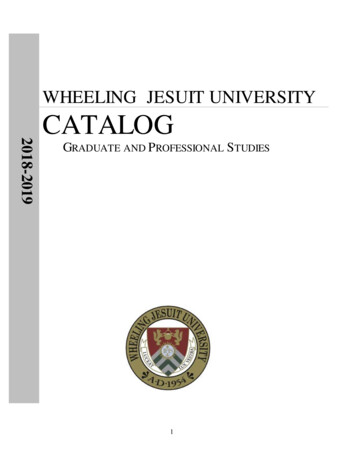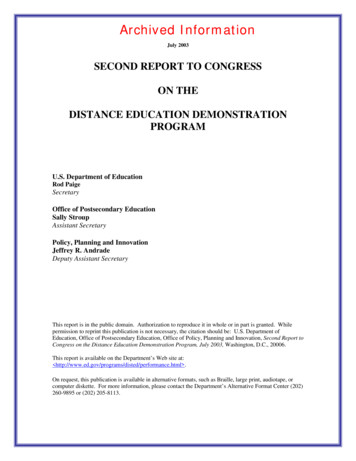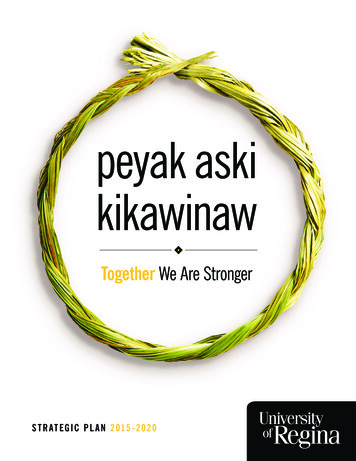
Transcription
peyak askikikawinawTogether We Are StrongerS T R AT E G I C P L A N 2 0 1 5 -2 0 2 0
peyak aski kikawinaw“We are one with Mother Earth”Sweetgrass has been used by the First Nations people of the Great Plainsfor millennia to cleanse, heal and prepare for ceremony. Elders teach usthat sweetgrass is the hair of Mother Earth and that each of the threestrands of the sweetgrass represent body, spirit and mind.Many minds, unique in perspective but united in purpose,envisioned our new strategic plan, peyak aski kikawinaw.And now, like the braided strands of the sweetgrass,we are woven together – one body, one spirit,one mind – with one vision for our future.Together we are stronger.
UNIVERSITY OF REGINA STRATEGIC PLAN 2015-2020Table of ContentsA Vision for the Future. 4From Then to Now: The Context & Process. 5Our Vision, Mission & Values. 7Our Strategic Priorities: . 82015-2020 Strategic Plan . 8An Implementation Framework to Achieve the University of Regina Strategic Plan . 18Strategic Planning Facilitation Team . 22PA G E 3
UNIVERSITY OF REGINA STRATEGIC PLAN 2015-2020Together we are strongerThe sweetgrass braid is a powerful and fitting symbol of the University of Regina’s 2015-2020 strategic plan.Entitled peyak aski kikawinaw – Cree for “We are one with Mother Earth” – this plan builds on our rich heritage,recognizes the growing importance of our place in the world, and brings together many strands of thought to setforth a bold collective vision for the future.It should not be surprising that such a vision has emerged from a university in Saskatchewan, where our provincialmotto translates to “From Many Peoples, Strength.” Our strategic plan came into being through the involvementof many people – faculty, staff, students, alumni, University Council, Senate, the Board of Governors, andmembers of the larger community – who provided both general guidance and specific input that were critical tothe plan’s development.The resulting plan identifies and expands upon three key priorities – student success, research impact, andcommitment to our communities – that will be crucial for the University of Regina’s success over the next five yearsand beyond. At the same time, the plan includes Indigenization and sustainability as overarching areas of emphasisthat contribute to our shared vision of being a national leader in developing educated contributors, career-readylearners, and global citizens while generating meaningful, high impact scholarship.peyak aski kikawinaw has within it the means of realizing our collective vision for post-secondary education –a vision for which we are all responsible. In the coming years, we must continue working together to bring thisvision to life.By assuming this responsibility, we will rise to the challenge we have set for ourselves. Together we are stronger,and an even stronger University of Regina will be the result of our collective efforts.Dr. Vianne TimmonsPresident and Vice-ChancellorPA G E 4Lee ElliottChair, Board of Governors
UNIVERSITY OF REGINA STRATEGIC PLAN 2015-2020From Then to Now: The Context & ProcessUpdate on Previous Plan AccomplishmentsThe University’s 2009-2014 Strategic Plan, mâmawohkamâtowin, Our Work, Our People, Our Communities,has served us well over the past five years. The implementation of this Plan has strengthened the University ina number of key areas, and has helped bring about many accomplishments. Some highlights are: Significant growth in student enrolment and retention. Total enrolments have grown by 17% from Fall 2009to Fall 2014, setting record highs in the past four years and closely approaching 14,000 students. Increased relevance for Aboriginal, international, and graduate students. From 2009 to 2014, the number ofself-declared Aboriginal students has grown by nearly 50% and now makes up 11% of the student population. International student growth. From 2009 to 2014, international student enrolments grew by more than 96%to comprise 13% of all students. Over 1800 students from more than 90 countries are enrolled in creditstudies while more 350 students are in the non-credit English as a Second Language preparatory program. Graduate studies expansion. From 2009 to 2014, graduate student enrolments have increased 13%. Continued program development including the establishment of a very successful undergraduate Nursingprogram with 1,205 students now enrolled, new Master’s degree programs in areas such as HealthAdministration, Journalism, and Nursing, the revamped MBA program, and successful national accreditationsin areas including Engineering, Nursing, Actuarial Science, and Clinical Psychology. A renewed commitment to teaching and learning through the Strategic Plan for Teaching and Learning,a new suite of faculty teaching awards, and increased response to shifting patterns of student needs bydoubling the number of online courses, increasing early morning, evening, weekend and spring/summerofferings, and continuing to expand course offerings in areas of high student demand. The University of Regina currently leads Canadian comprehensive universities in research impact1 andresearch collaboration.2 Approximately 1,400 students participating in the UR Guarantee Program, which has been designed to keepthem engaged in campus life and support their transition from university to employment. Significant increases in student financial assistance, with help from new provincial government programs.The operating budget allocation for scholarships has more than doubled from 2009-10 to 2014-15 from 3.7 million to 7.6 million. Among 14 comprehensive Canadian universities, the University of Regina rankssecond-highest in total financial aid to students (all university sources) as a percentage of tuition revenue(35% in 2012-13). The University of Regina is the only postsecondary institution in Saskatchewan to offer programming, acrossmultiple academic programs, in both of Canada’s official languages. The President’s Task Force on the Future of the Institut français recommended measures to strengthen Frenchlanguage programming. These recommendations are now being implemented. For the time period spanning 2004-2013, the University’s “impact” as calculated by Thomson Reuters’ NCI (including all Web of Science subject areas)exceeded that of a comparator group of SFU, UVic, York, Waterloo, Guelph, UofS, and UNB.2Research InfoSource, Spotlife on International Research Collaboration, hensive.pdf.1PA G E 5
UNIVERSITY OF REGINA STRATEGIC PLAN 2015-2020 A growing number of experiential and international learning opportunities, with a record of more than800 Co-operative education work placements in 2013 and more than 800 domestic students studying abroadover the past four years. Earnings by students in Co-op and other work placements now total more than 9 million annually. The implementation of a number of important initiatives to help Indigenize the University for all membersof the campus community. The success of Aboriginal students, faculty and staff on our campuses has beensupported through the expansion of the Aboriginal Student Centre and the establishment of the AboriginalAdvisory Circle. The University has increased the resources of the Centre for Student Accessibility, enabling it to provide enhancedservices and support to students with disabilities so that they can approach their studies as other students do. Enhanced engagement with the larger community through initiatives such as the President’s CommunityAward. This engagement has helped increase the amount of annual donor contributions.For a more complete summary, go to -14-sp-accomplishments.pdf.Environmental Scan ConsiderationsAlthough the University of Regina has made significant progress over the past five years, we – like mostCanadian universities – face a series of challenges: Financial challenges stemming from constraints on government contributions to operating and capital budgets; Faculty concerns regarding the direction of our academic mission, the balance between professional and nonprofessional programs, and the amount of support available for research and graduate students; Increasing student demand for career-directed and professional education; The responsibility to serve an increasingly diverse group of new Saskatchewan learners as noted inThe Saskatchewan Plan for Growth; The need to make postsecondary education more accessible to a growing Aboriginal population in the province; Technological advancements and the challenge of adapting to them; A new generation of students with different interests and characteristics; and The aging physical infrastructure of our campuses.These internal and external trends provided motivation and a sense of necessity for renewing the University’sStrategic Plan. More detailed information can be found in the 2014 Environmental Scan, which provided contextand considerations for the priorities and objectives defined in this new Strategic Plan.Overview of Strategic Planning ProcessIn Winter 2014, a 15-person strategic planning facilitation team came together. Their task: to hear a rich andwide variety of input from hundreds of faculty, staff, students, alumni, community members, and other Universitystakeholders and community partners, and then, working from that input, to guide the development of thisnew Strategic Plan. Through extensive face-to-face consultation sessions, student postcard suggestions, emailsubmissions, and web-based fora, blogs, and online forms, the team listened to the thoughts, ideas and dreamspeople have for the University of Regina for the next five years and beyond. This valuable feedback from hundredsof individuals was central to the team’s work in putting together the 2015-20 Strategic Plan.PA G E 6
UNIVERSITY OF REGINA STRATEGIC PLAN 2015-2020Our Vision, Mission & ValuesVision StatementThe University of Regina aspires to be a national leader in developing educated contributors, career-ready learners,and global citizens, and in generating meaningful, high-impact scholarship.Mission StatementThe University of Regina: Provides high quality and accessible education, influential research, creative endeavours, and meaningfulscholarly experiences in pursuit of local and global contributions to knowledge; Serves and engages a diversity of students, life-long learners, and communities, with particular emphasis onAboriginal learners and global citizens; Offers a welcoming and rewarding academic and work environment for students, faculty, and staff; and Fosters innovative learning, community engagement, and critical and independent thought.ValuesMutual Respect, Integrity & Honesty: We are a scholarly community engaged with many other communities.The members of our community are our defining resource. Our treatment of each other is principled, open,transparent and respectful.Inclusivity & Diversity: We are a learning community. We value interaction between faculty members and studentsas the fundamental activity of the academy. We recognize and support the diversity of our students’ needs, andare inclusive of our Aboriginal, new Canadian, and international students, employees and partners. We aim tobe accessible to all who wish to learn with us. We welcome the world to our campuses.Pursuit of Knowledge: We have a driving urge to know the unknown. Our investigation of and reflection uponvaried intellectual pursuits is fundamental to us. We engage our students in these pursuits, seeking to instil inthem a lifelong quest for knowledge and understanding. We reaffirm our commitment to education in the liberalarts, which is the historic core of our academic offerings. We balance our duty to academic integrity with ourcommitment to academic freedom in our work and interactions.Community & Social Responsibility: We employ our expertise to serve each other and society. We illuminate pressingsocial problems and seek solutions. The knowledge we generate enriches the community. We are legitimatelyconcerned with all aspects of our world. We are a bridge and an interpreter between our communities, otherpeople and other nations.Accountability & Well-Being: We are accountable for our performance to each other, our students, our alumni and thepublic. We value a safe, healthy, and supportive community.PA G E 7
UNIVERSITY OF REGINA STRATEGIC PLAN 2015-2020Our Strategic Priorities:2015-2020 Strategic PlanOver the next five years, the University of Regina is committed to three Strategic o OurCommunitiesIndigenization & SustainabilityStudent Success: A vibrant,challenging and stimulatinglearning environment withthe services required to allowfor student engagement,achievement, personal growth,academic success and careerreadiness.PA G E 8Research Impact: An intellectuallyactive and innovative researchcommunity with the supportsand infrastructure to expand theboundaries of knowledge andto have a meaningful impactat home and beyond.Commitment to Our Communities:A community of dedicated andpassionate students, alumni,staff, and faculty who embraceour responsibilities to serve andengage our diverse peoples andcommunities in the pursuit ofwell-being and pride of place.
UNIVERSITY OF REGINA STRATEGIC PLAN 2015-2020The University has also identified two overarching areas of emphasis that thread throughout each priority,and upon which we will continue to build to increase our impact, reputation and competitiveness:1. Indigenization3: The University of Regina is situated on Treaty 4 and Treaty 6 lands. Aboriginal students,employees and community members are welcomed and supported at the University of Regina. Since theinception of the 2009-2014 Strategic Plan, we have been focused on implementing important initiatives tosupport the success of Aboriginal students, faculty and staff on our campuses, and Indigenize the University.This momentum is embedded and expanded in the 2015-2020 Strategic Plan.2. Sustainability: Commitment to sustainability is critical to ensure institutional and societal longevity andsuccess into the future. At the University of Regina sustainability is deeply rooted in social justice and is takento encompass economic, cultural, social, and environmental sustainability.For each Strategic Priority, the following components have been defined to provide further direction and focusfor the University’s planning, resource allocations and efforts. Objectives: Provides defined goals or accomplishments that the University desires to achieve within each of theStrategic Priority areas (“The What”). Indicators of Success: Provides recommendations for specific measures that allow us to assess our progress andperformance toward achieving the intended objective (“The Result”). The Board of Governors is responsible fordeveloping metrics in an annual Performance Measurement Framework document. The proposed indicatorsin this plan will guide the development of these annual measures. Supporting Actions: Provides further direction for actions and efforts to be implemented in order to supportachieving the desired objectives and intended results (“The How”). The lists of Supporting Actions are notexhaustive. Individual Faculties, departments and units should view them as starting points and develop morespecific Supporting Actions through their own strategic and operational planning.3 The Aboriginal Advisory Circle to the President (AAC) defines Indigenization as “the transformation of the existing academy by including Indigenousknowledges, voices, critiques, scholars, students and materials as well as the establishment of physical and epistemic spaces that facilitate the ethical stewardshipof a plurality of Indigenous knowledges and practices so thoroughly as to constitute an essential element of the university. It is not limited to Indigenous people,but encompasses all students and faculty, for the benefit of our academic integrity and our social viability.”PA G E 9
UNIVERSITY OF REGINA STRATEGIC PLAN 2015-2020Strategic Priority: Student SuccessThe University of Regina exists to provide quality postsecondary education to our students. Guided by the StrategicPlan for Teaching and Learning, the University will strive to provide the necessary supports required to meet diversestudent needs. Together, we will work to ensure that all of our students are given the opportunity to encounter avariety of perspectives, reflect critically on their assumptions, and communicate effectively on a range of subjects.STUDENT SUCCESS OBJECTIVE:Enhance supports to better facilitate student preparedness for academic success.Indicators of Success: Increased retention and success rates of first-year students. Increased completion rates of Aboriginal students. Increased completion rates of international students. Increased proportion of graduate students completing programs in a timely manner. Increased research and scholarly dissemination by graduate students. Increased retention rate of all students.Supporting Actions: Improve supports offered to new students transitioning into university. Develop and implement retention strategies that reflect current student needs. Develop and implement a strategy to evaluate the effectiveness of student support services. Expand linkages with Saskatchewan school boards to better facilitate student preparedness forsuccess at university. Enhance services and academic supports for Aboriginal students. Enhance services and academic supports to assist international and new Canadian studentstransitioning to Canada, with particular emphasis on English Language proficiency, Canadian culture,and university expectations. Enhance teaching and learning supports for staff and faculty who, facing new classroom realities, areadopting new methodologies and pedagogic strategies. Develop and implement a strategy to improve time to completion for graduate students.PA G E 1 0
UNIVERSITY OF REGINA STRATEGIC PLAN 2015-2020STUDENT SUCCESS OBJECTIVE:Embed Indigenous practices, ideas and principles in our academic pursuits.Indicators of Success: Increased Indigenization in each Faculty and academic unit. Increased resources focused on Indigenization efforts. Increased academic programming partnerships and collaborations with First NationsUniversity of Canada. Increased number of Indigenous learning spaces.Supporting Actions: Provide workshops and resources for all faculty to build understanding about Indigenizingour teaching. Offer course(s) in each academic program that address Indigenous concepts. Engage with First Nations University of Canada to develop partnerships that clearly articulate ways totake advantage of each other’s academic programming without duplication. Respect and practice traditional ways of knowing in our curricula and pedagogical practice by learningfrom Elders and local traditional knowledge keepers. Develop Indigenizing teaching spaces where ceremony is both integral and expected. Facilitate Indigenous knowledge and action in support of sustainability across our university.STUDENT SUCCESS OBJECTIVE:Strengthen the quality and impact of teaching and learning for all students.Indicators of Success: Increased tenured and tenure-track faculty. Improved student and alumni satisfaction rates. Increased effective and flexible learning opportunities offered. Increased student appreciation of the value of education beyond career goals.Supporting Actions: Develop and implement a strategy for creating tenure-track faculty positions. Implement the goals and actions of the Strategic Plan for Teaching and Learning. Facilitate the integration of the liberal arts across disciplines. Expand learning opportunities for part-time, online, distance and lifelong learners across allour campuses.PA G E 1 1
UNIVERSITY OF REGINA STRATEGIC PLAN 2015-2020 Develop interdisciplinary approaches to curriculum design and delivery between Facultiesand departments. Practise instructional strategies that aim to meet the needs of an increasingly diverse group of learners(culturally-sensitive, anti-oppressive, anti-racist, etc.). Provide services to support the continued development of an inclusive university that recognizes thediversity of our student populations. Promote the development in every discipline of curricula that allow students to “acquire the knowledge,skills, attitudes and values necessary to shape a sustainable future”.4STUDENT SUCCESS OBJECTIVE:Expand and enhance experiential and service learning opportunities in academic programming.Indicators of Success: Will have demonstrated progress toward providing enhanced experiential and servicelearning opportunities. Increased the number of graduating students who have engaged in experiential, service learning,and international study opportunities.Supporting Actions: Identify and reduce barriers to participation in experiential learning opportunities during the course of astudent’s degree. Expand and promote experiential and service learning opportunities, including international learning,community service learning and co-op/practicum/internship opportunities. Infuse curricula with applied experiences through placements, case-based projects, research, studiesabroad, group work, community service, and senior capstone projects. Promote the adoption of sustainability components in experiential learning opportunities. UNESCO Education for Sustainable Development.4PA G E 1 2
UNIVERSITY OF REGINA STRATEGIC PLAN 2015-2020Strategic Priority: Research Impact“Research” encompasses creative endeavours and other scholarly activities that foster new knowledge. Critical tothe University’s success are its strategic research clusters, which have been identified as a function of their criticalmass (highly-qualified personnel), performance (impact) and distinctiveness: Anxiety, Stress & Pain The DigitalFuture Water, Environment, & Clean Energy Health Equity Social Justice & Community Safety.5 Not only isit key that the University continues focusing on high-impact research, but it is essential that research successes arecommunicated and celebrated within the community.R E S E A R C H I M PA C T O B J E C T I V E :Strengthen support required for students and researchers to deliver high impact outcomes.Indicators of Success: Increased funding and titled scholarships for supporting and recruiting high-calibre graduate students. Increased Tri-Council funding, alumni-funded research monies and other partnership research monies. Increased success rate of external grant applications. Increased number of research-related partnerships specific to the strategic research clusters. Increased amount of research in and about Saskatchewan for the benefit of Saskatchewan residents. Increased research publication impact factors. Increased funding support for, and professional recognition of, community-engaged scholarship. Increased research impacts in our communities and in public policy.Supporting Actions: Increase the research funding budget. Prioritize research resources and develop new funding partnerships that align with the five strategicresearch clusters. Stimulate new research partnerships and funding opportunities that are responsive to community needsand build capacity with local communities, including First Nations and Métis communities. Increase institutional research support for grant writing and research administration. Encourage the development of interdisciplinary research and academic programming among Faculties,the Library and departments through an internal interdisciplinary funding program. Increase support for research on topics with relevance to sustainability.5 Vice-President (Research).PA G E 1 3
UNIVERSITY OF REGINA STRATEGIC PLAN 2015-2020R E S E A R C H I M PA C T O B J E C T I V E :Advance the profile and awareness of research successes locally, provincially, nationally and internationally.Indicators of Success: Increased number of external research partnerships. Increased number of positive research articles/stories in the local media. Increased proportion of stories on the University’s website and media releases devoted to research. Research-related communication strategy developed and implemented. Increased number of enquiries for University expertise. University becomes an essential partner to address community issues and concerns. University known as a leader in environmental sustainability.Supporting Actions: Increase the number of public presentations of research findings. Profile University of Regina research successes internally and externally. Create a targeted communications strategy to keep University of Regina stakeholders, communitymembers, and Indigenous media updated on research developments. Provide necessary resources to publicize our research successes. Foster the development of more community-based research projects. Implement key strategic recommendations from the Sustainability Strategic Plan. Continue to build partnerships through the United Nations University Regional Centres of Expertise onEducation for Sustainable Development. Enhance research collaborations with other universities and colleges, both in Canada and internationally.R E S E A R C H I M PA C T O B J E C T I V E :Increase research partnerships and projects with First Nations and Métis people,communities and organizations, including the First Nations University of Canada.Indicators of Success: Increased internal and external funding specific to Indigenous research. Increased supports for faculty and students to practise Indigenous-based research. The diversity of ways that Indigenous inquiry is undertaken is appreciated and celebrated. Increased number of publications and presentations of Indigenous-based research.Supporting Actions: Develop a strategy to enhance Indigenous research in partnership with First Nations University ofCanada, the Gabriel Dumont Institute and other potential partners. Regularly host an Indigenous research showcase to broaden awareness of Indigenous research andIndigenous research methods. Encourage and support awareness of Indigenous ways of knowing in research and graduate programs.PA G E 1 4
UNIVERSITY OF REGINA STRATEGIC PLAN 2015-2020Strategic Priority: Commitment to Our CommunitiesThe University of Regina’s motto, As One Who Serves, speaks to the deep connection and commitment to serving allof the communities the University touches in Saskatchewan, across Canada, and around the world. The Universityis committed to collaborative community service and engagement opportunities. This includes the communitieswithin the institution as well as people and organizations external to the academy at the local, provincial, national,and global levels. This priority focuses on our people, on institutional sustainability, and on the importance ofengaging with our communities in order to improve institutional and personal well-being through actions thataddress needs in our community.COMMITMENT TO OUR COMMUNITIES OBJECTIVE :Focus on our people by continuing to build a friendly, respectful, diverse, safe and welcoming university for all.Indicators of Success: Increased satisfaction with accessibility services. Increased satisfaction related to diversity and culturally responsive needs being met. Improved mental health support services for students, faculty and staff. Sustained employee engagement results and retention rates. Increased attendance at University events by students, faculty, staff, alumni and community members. Progressed toward building a representative workforce reflective of the province’s diverse population.Supporting Actions: Increase awareness and appreciation among students, faculty and staff of Indigenous history, peopleand contemporary issues. Improve accessibility on our campuses for all students, employees and members of the public. Foster stronger ties between the academy, the undergraduate Students’ Union (URSU), the GraduateStudents’ Association (URGSA) and the Alumni Association (URAA). Implement recommendations from the President’s Task Force on the future of the Institut français. Build a strong university community spirit among students, alumni, staff and faculty. Increase diversity among our campus communities with culturally responsive initiatives, activitiesand services. Develop a strategy to work toward a representative workforce. Develop a comprehensive program of mental health awareness and support for students, facultyand staff. Enhance opportunities and support for student and employee physical well-being. Formalize and support programs to provide opportunities for all University employees to participatein professional development. Promote a healthy work-life balance.PA G E 1 5
UNIVERSITY OF REGINA STRATEGIC PLAN 2015-2020COMMITMENT TO OUR COMMUNITIES OBJECTIVE :Focus on institutional sustainability and transparency to ensure that we area preferred institution at
ES EGA STRATEGIC PLAN 2015-2020 PAGE 4 The sweetgrass braid is a powerful and fitting symbol of the University of Regina's 2015-2020 strategic plan. Entitled peyak aski kikawinaw - Cree for "We are one with Mother Earth" - this plan builds on our rich heritage, recognizes the growing importance of our place in the world, and brings together many strands of thought to set
